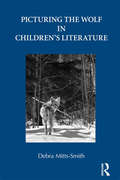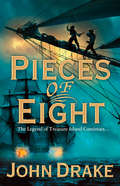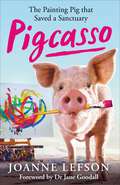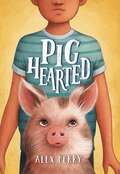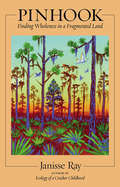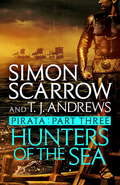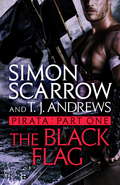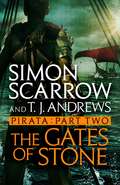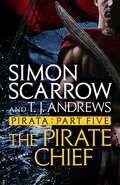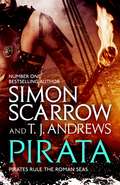- Table View
- List View
The Picnic Cookbook: Outdoor Feasts For Every Occasion (National Trust Food Ser.)
by Laura MasonPicnics and outdoor meals are a classic theme in British food. Afternoon tea in the garden on a golden afternoon in late summer, a packed lunch consumed on a hilltop while the eyes feast on a magnificent view, and the tantalising smell of grilling from a barbecue are all part of this. Being outside sharpens the senses and the appetite, refreshes the soul and gives different perspectives – and National Trust properties provide a wealth of different environments in which to enjoy food outdoors. The book will include over 100 recipes covering picnics, barbecues and campfire food. They range from bresola rolls and lemon gin to be enjoyed as a punting picnic, to a warming minestrone and spiced parkin for bonfire night, a baba ganoush made with aubergines chargrilled on the barbecue, and mussels wrapped in seaweed and cooked on the embers of a campfire. Author Laura Mason gives tips on transporting and cooking the food in the great outdoors, as well as giving historical context to the recipes and suggesting the best National Trust places to eat outdoors.
Picturing the Wolf in Children's Literature
by Debra Mitts-SmithFrom the villainous beast of “Little Red Riding Hood” and “The Three Little Pigs,” to the nurturing wolves of Romulus and Remus and Rudyard Kipling’s The Jungle Book, the wolf has long been a part of the landscape of children’s literature. Meanwhile, since the 1960s and the popularization of scientific research on these animals, children’s books have begun to feature more nuanced views. In Picturing the Wolf in Children’s Literature, Mitts-Smith analyzes visual images of the wolf in children’s books published in Western Europe and North America from 1500 to the present. In particular, she considers how wolves are depicted in and across particular works, the values and attitudes that inform these depictions, and how the concept of the wolf has changed over time. What she discovers is that illustrations and photos in works for children impart social, cultural, and scientific information not only about wolves, but also about humans and human behavior.
Picturing the Wolf in Children's Literature (PDF)
by Debra Mitts-SmithFrom the villainous beast of “Little Red Riding Hood” and “The Three Little Pigs,” to the nurturing wolves of Romulus and Remus and Rudyard Kipling’s The Jungle Book, the wolf has long been a part of the landscape of children’s literature. Meanwhile, since the 1960s and the popularization of scientific research on these animals, children’s books have begun to feature more nuanced views. In Picturing the Wolf in Children’s Literature, Mitts-Smith analyzes visual images of the wolf in children’s books published in Western Europe and North America from 1500 to the present. In particular, she considers how wolves are depicted in and across particular works, the values and attitudes that inform these depictions, and how the concept of the wolf has changed over time. What she discovers is that illustrations and photos in works for children impart social, cultural, and scientific information not only about wolves, but also about humans and human behavior. First encountered in childhood, picture books act as a training ground where the young learn both how to decode the “symbolic” wolf across various contexts and how to make sense of “real” wolves. Mitts-Smith studies sources including myths, legends, fables, folk and fairy tales, fractured tales, fictional stories, and nonfiction, highlighting those instances in which images play a major role, including illustrated anthologies, chapbooks, picture books, and informational books. This book will be of interest to children’s literature scholars, as well as those interested in the figure of the wolf and how it has been informed over time.
Pieces of Eight
by John DrakeThe second in the rip-roaring adventure series of ‘Treasure Island’ prequels for fans of ‘Pirates of the Caribbean’
The Pig: A Natural History
by Richard LutwycheA comprehensive, richly illustrated introduction to the fascinating natural history of the pig, from prehistory to the present At any given time, there are around one billion pigs in the world; that's one for every seven of us. And where would we be without them? Prolific, ubiquitous, smart, adaptable, and providers of high-quality protein, pigs have been our companions since neolithic times, when they obligingly domesticated themselves, coming in from the wild to root around our waste pits. But it's not all about the bacon; today, bred in micro sizes, the resourceful pig has developed a whole new career as a popular pet. And thanks to genome mapping, we now know that the pig shares many common physiological features with humans, spurring the use of pig tissue and organs in medical research and surgery. Beautifully designed and illustrated, The Pig provides a snout-to-tail natural history of this important species, from the prehistoric "hell pig" to today's placid porker, covering the pig's evolution and domestication, anatomy and biology, behavior, role in human life and culture, and breeds. The book also features an engrossing and visually stunning photographic gallery of some thirty popular breeds from around the world, with essential information about each. Filled with surprising facts and insights, The Pig will delight anyone who loves these animals and wants to understand them better.Provides a comprehensive, richly illustrated introduction to the pig's evolution and domestication, anatomy and biology, behavior, role in human life and culture, and breedsFeatures infographics, diagrams, and 250 stunning color photographsIncludes a beautiful photographic directory to some 30 popular breeds from around the world, with essential information about each
The Pig: A Natural History
by Richard LutwycheA comprehensive, richly illustrated introduction to the fascinating natural history of the pig, from prehistory to the present At any given time, there are around one billion pigs in the world; that's one for every seven of us. And where would we be without them? Prolific, ubiquitous, smart, adaptable, and providers of high-quality protein, pigs have been our companions since neolithic times, when they obligingly domesticated themselves, coming in from the wild to root around our waste pits. But it's not all about the bacon; today, bred in micro sizes, the resourceful pig has developed a whole new career as a popular pet. And thanks to genome mapping, we now know that the pig shares many common physiological features with humans, spurring the use of pig tissue and organs in medical research and surgery. Beautifully designed and illustrated, The Pig provides a snout-to-tail natural history of this important species, from the prehistoric "hell pig" to today's placid porker, covering the pig's evolution and domestication, anatomy and biology, behavior, role in human life and culture, and breeds. The book also features an engrossing and visually stunning photographic gallery of some thirty popular breeds from around the world, with essential information about each. Filled with surprising facts and insights, The Pig will delight anyone who loves these animals and wants to understand them better.Provides a comprehensive, richly illustrated introduction to the pig's evolution and domestication, anatomy and biology, behavior, role in human life and culture, and breedsFeatures infographics, diagrams, and 250 stunning color photographsIncludes a beautiful photographic directory to some 30 popular breeds from around the world, with essential information about each
Pigcasso: The painting pig that saved a sanctuary
by Joanne LefsonWhen Joanne Lefson took on a piglet at her animal shelter, the young sow proceeded to eat everything in her stable but a paint brush. In a flash of inspiration, Joanne attempted to introduce the pig to the art of painting - and thus Pigcasso was born. Starting out with a humble canvas on the sanctuary wall, Pigcasso's paintings are now owned by the likes of George Clooney, she has a Swatch watch design partnership, a wine label, and has eclipsed the previous world record holder for animal art. She's been commissioned by Nissan and has had exhibitions in Cape Town, Munich and Amsterdam. More than that, Pigcasso's art funds the food and veterinary services for all the animals at the sanctuary.Pigcasso is the story of this unique pig and of the circumstances that brought her and Joanne together to take the art world by storm and form a unique and unbreakable bond.
Pigeon River Country: A Michigan Forest
by Dale Clarke FranzThe long awaited new edition of a classic offers memories, myths, and meanings of the largest contiguous piece of wild land in Michigan's Lower Peninsula. This updated edition explores more deeply why and how the outdoors moves and compels us. It’s a book about mice who sing, elk who wear collars, deer who kiss, and birds who could dictate their compositions to Mozart. It's about the human species interacting in generous and sometimes misguided ways with the rest of life. It's about men trying to ripen pinecones into pineapples and women taking better aim with a revolver than expected. It's about poetry—from Mary Oliver, Lao Tzu, and Theodore Roethke—and seeing hawks dive in a night sky or feeling oil geologists shake the earth below. It's about finding fish dead in the river by the thousands and crouching behind a stump to watch beaver build a dwelling. While this book considers life beyond the boundaries of Pigeon River Country, it is steeped in the specifics of a place that lives mostly on its own, instead of human, terms. The Pigeon River Country is a remote northern forest, ecologically distinct from most of the United States. Laced with waterways, it has a storied past. Dale Clarke Franz has collected personal accounts from various people intrigued with the Pigeon River Country—including loggers, conservationists, mill workers, campers, even the young Ernest Hemingway, who said he loved the forest "better than anything in the world." There are comprehensive discussions of the area's flora and fauna, guides to trails and camping sites, and photos showcasing the changing face of this hidden national treasure.
Pighearted
by Alex PerryCharlotte's Web meets My Sister's Keeper in this charming story told from the alternating perspectives of a boy with a fatal heart condition and the pig with the heart that could save his life.Jeremiah&’s heart skips a beat before his first soccer game, but it&’s not nerves. It&’s the first sign of a heart attack. He knows he needs to go to the hospital, but he&’s determined to score a goal. Charging after the ball, he refuses to stop…even if his heart does.J6 is a pig and the only one of his five brothers who survived the research lab. Though he's never left his cell, he thinks of himself as a therapy pig, a scholar, and a bodyguard. But when the lab sends him to live with Jeremiah's family, there&’s one new title he&’s desperate to have: brother.At first, Jeremiah thinks his parents took in J6 to cheer him up. But before long, he begins to suspect there's more to his new curly-tailed companion than meets the eye. When the truth is revealed, Jeremiah and J6 must protect each other at all costs—even if their lives depend on it.
Pilgrim on the Great Bird Continent: The Importance of Everything and Other Lessons from Darwin's Lost Notebooks
by Lyanda Lynn HauptBy focusing mostly on the birds Charles Darwin observed, and by brilliantly mining his lesser-known writings, Haupt pens a startlingly fresh exploration of the man's genius that invites readers to look at the world with new eyes.
Pilgrims of the Vertical: Yosemite Rock Climbers and Nature at Risk
by Joseph E. Taylor Joseph E TaylorFew things suggest rugged individualism as powerfully as the solitary mountaineer testing his or her mettle in the rough country. Yet the long history of wilderness sport complicates this image. In this surprising story of the premier rock-climbing venue in the United States, Pilgrims of the Vertical offers insight into the nature of wilderness adventure. From the founding era of mountain climbing in Victorian Europe to present-day climbing gyms, Pilgrims of the Vertical shows how ever-changing alignments of nature, technology, gender, sport, and consumer culture have shaped climbers’ relations to nature and to each other. Even in Yosemite Valley, a premier site for sporting and environmental culture since the 1800s, elite athletes cannot be entirely disentangled from the many men and women seeking recreation and camaraderie. Following these climbers through time, Joseph Taylor uncovers lessons about the relationship of individuals to groups, sport to society, and nature to culture. He also shows how social and historical contexts influenced adventurers’ choices and experiences, and why some became leading environmental activists—including John Muir, David Brower, and Yvon Chouinard. In a world in which wild nature is increasingly associated with play, and virtuous play with environmental values, Pilgrims of the Vertical explains when and how these ideas developed, and why they became intimately linked to consumerism.
Pilot Society and the Energy Transition: The co-shaping of innovation, participation and politics
by Marianne Ryghaug Tomas Moe SkjølsvoldThis open access book examines the role of pilot and demonstration projects as crucial devices for conducting innovation in the context of the energy transition. Bridging literature from sustainability transitions and Science and Technology Studies (STS), it argues that such projects play a crucial role, not only in shaping future energy and mobility systems, but in transforming societies more broadly. Pilot projects constitute socio-technical configurations where imagined future realities are materialized. With this as a backdrop, the book explores pilot projects as political entities, focusing on questions of how they gain their legitimacy, which resources are mobilized in their production, and how they can serve as sites of public participation and the production of energy citizenship. The book argues that such projects too often have a narrow technology focus, and that this is a missed opportunity. The book concludes by critically discussing the potential roles of research and innovation policy in transforming how such projects are configured and conducted.
Pilzgeschichten: Wissenswertes aus der Mykologie
by Hans Kothe Erika KotheWer bei Pilzen nur an leckere Champignons oder giftige Fliegenpilze denkt, wird von diesem Buch überrascht sein. Die beiden Pilzforscher Hans und Erika Kothe laden Sie zu einer informativen und unterhaltsamen Rundreise durch die vielgestaltige Welt der Pilze ein. Historische Anekdoten und aktuelle Beispiele veranschaulichen die biologische, medizinische und ökologische Bedeutung der Pilze.
Pinhook: Finding Wholeness in a Fragmented Land
by Janisse RayJanisse Ray, award-winning author of Ecology of a Cracker Childhood and Wild Card Quilt, writes an evocative paean to wildness and wilderness restoration with an extraordinary journey into southern Georgia's Pinhook Swamp. Pinhook Swamp acts as a vital watershed and wildlife corridor, a link between the great southern wildernesses of Okefenokee Swamp and Osceola National Forest. Together Okefenokee, Osceola, and Pinhook form one of the largest expanse of protected wild land east of the Mississippi River. This is one of America's last truly wild places, and Pinhook takes us into its heart. Ray comes to know Pinhook intimately as she joins the fight to protect it, spending the night in the swamp, tasting honey made from its flowers, tracking wildlife, and talking to others about their relationship with the swamp. Ray sees Pinhook through the eyes of the people who live there--naturalists, beekeepers, homesteaders, hunters, and locals at the country store. In lyrical, down-home prose, she draws together the swamp's need for restoration and the human desire for wholeness and wildness in our own lives and landscapes.
Pinnipeds and El Niño: Responses to Environmental Stress (Ecological Studies #88)
by Fritz Trillmich Kathryn A. OnoEl Niño is a meteorological and oceanographic phenomenon, which occurs at irregular intervals in the eastern tropical Pacific. Its most obvious characteristic is the warming of surface waters, which causes enormous disturbances of the marine environment. A severe Niño may also affect continental systems worldwide. This book gathers in a comprehensive way the information available on the effects of the exceptionally strong 1982-83 Niño on a group of marine mammals, the pinnipeds. It presents an analysis of the effects of environmental stress on the populations of top predators. Data and interpretations are based on a most unusual collection of long-term studies of pinniped population dynamics, behavior and ecology which spanned the El Niño event. The responses of pinniped populations to the El Niño disturbance of the marine ecosystem also has important implications for the management and conservation of marine mammal populations.
Pioneer on Indigenous Rights (SpringerBriefs on Pioneers in Science and Practice #2)
by Rodolfo StavenhagenOn the occasion of the 80th birthday of Rodolfo Stavenhagen, a distinguished Mexican sociologist and professor emeritus of El Colegio de Mexico, Úrsula Oswald Spring (UNAM/CRIM, Mexico) introduces him as a Pioneer on Indigenous Rights due to his research on human rights issues, especially when he served as United Nations Special Rapporteur on the rights of indigenous peoples. First, in a retrospective Stavenhagen reviews his scientific and political work for the rights of indigenous peoples. Seven of his classic texts address Seven Fallacies about Latin America (1965); Decolonializing Applied Social Sciences (1971); Ethnodevelopment: A Neglected Dimension in Development Thinking (1986); Human Rights and Wrongs: A Place for Anthropologists? (1998); Indigenous Peoples and the State in Latin America: An Ongoing Debate (2000); Building Intercultural Citizenship through Education: A Human Rights Approach (2006); and Making the Declaration Work (2006). This volume discusses the emergence of indigenous peoples as new social and political actors at the national level in numerous countries, as well as on the international scene. This book introduces a trilogy of Briefs on Rodolfo Stavenhagen published in the same series Pioneers in Science and Practice.
Pioneering Conservation in Alaska (G - Reference, Information And Interdisciplinary Subjects Ser.)
by Ken RossA companion volume to Environmental Conflict in Alaska, Pioneering Conservation in Alaska chronicles the central land and wildlife issues and the growth of environmental conservation in Alaska during its Russian and territorial eras. The Alaskan frontier tempted fur traders, whalers, salmon fishers, gold miners, hunters, and oilmen to take what they could without regard for long-term consequences. Wildlife species, ecosystems, and Native cultures suffered, sometimes irreparably. Damage to wildlife and lands drew the attention of environmentalists, including John Muir, who applied their influence to enact wildlife protection laws and set aside lands for conservation. Alaska served as a testing ground for emergent national resource policy in the United States, as environmental values of species and ecosystem sustainability replaced the unrestrained exploitation of Alaska's early frontier days. Efforts of conservation leaders and the territory's isolation, small human population, and late development prevented widespread destruction and gave Americans a unique opportunity to protect some of the world's most pristine wilderness. Enhanced by more than 100 photographs, Pioneering Conservation in Alaska illustrates the historical precedents for current natural resource disputes in Alaska and will fascinate readers interested in wildlife and conservation.
Pipeline Politics: Assessing the Benefits and Harms of Energy Policy
by Madelon L. FinkelAn essential review of the history, benefits, limitations, failures, and politics of pipelines, with a core focus on potential harms to environmental and human health.The United States holds the world record of having the largest network of energy pipelines, with more than 2.4 million miles of pipeline transporting oil or natural gas. Russia, China, and Canada as well as many other countries also have extensive pipelines. How safe is this means of transport, and is there a potential harm to the environment and human health? In this text, professor Madelon L. Finkel presents an essential and clearly-stated review of the pros and cons of transporting oil and natural gas by pipeline. Finkel dispels myths, inaccuracies, and misconceptions and highlights the potential dangers that must be considered in any country's energy policy.Pipeline Politics: Assessing the Benefits and Harms of Energy Policy provides a broad and accessible analysis of pipelines, from their history and safety to their politics and risks. Finkel examines the benefits and costs of pipelines in parallel as well as issues of environmental justice; the fairness of treatment of the people affected; and the development, implementation, and enforcement of pipeline laws, regulations, and policies.
Pipeline Politics: Assessing the Benefits and Harms of Energy Policy
by Madelon L. FinkelAn essential review of the history, benefits, limitations, failures, and politics of pipelines, with a core focus on potential harms to environmental and human health.The United States holds the world record of having the largest network of energy pipelines, with more than 2.4 million miles of pipeline transporting oil or natural gas. Russia, China, and Canada as well as many other countries also have extensive pipelines. How safe is this means of transport, and is there a potential harm to the environment and human health? In this text, professor Madelon L. Finkel presents an essential and clearly-stated review of the pros and cons of transporting oil and natural gas by pipeline. Finkel dispels myths, inaccuracies, and misconceptions and highlights the potential dangers that must be considered in any country's energy policy.Pipeline Politics: Assessing the Benefits and Harms of Energy Policy provides a broad and accessible analysis of pipelines, from their history and safety to their politics and risks. Finkel examines the benefits and costs of pipelines in parallel as well as issues of environmental justice; the fairness of treatment of the people affected; and the development, implementation, and enforcement of pipeline laws, regulations, and policies.
Pirata: Part four of the Roman Pirata series (Pirata)
by Simon ScarrowThe fourth in the new Roman pirate series of ebook novellas from the Sunday Times bestselling authors Simon Scarrow and T. J. Andrews.AD 25. Across the treacherous waters of the Adriaticum, rival pirate ships and Roman squadrons battle for control. Only the strongest can survive ... In the dangerous waters along the Illyrian coast, a feared pirate crew is on the hunt. Prey is elusive, for Prefect Canis of the Roman navy has forbidden merchant ships from sailing without an escort. Captain Bulla and his first mate, the young pirate Telemachus, are relieved when a rare target is sighted. But the presence of armed soldiers on board takes them by surprise, as a gang of pirates prepares to take on a highly trained enemy. Victory, if it comes, will be at a terrible price. There's shocking news to follow. Aware of Telemachus's growing prowess on the seas, the Romans have imprisoned his enslaved brother Nereus. As the men of Poseidon's Trident set sail for Italia, pursued by aggressive Roman warships, a plan is taking shape in Telemachus's mind. A plan only he would dare even to think of ...Episode four in the PIRATA ebook novella series.
Pirata: Part three of the Roman Pirata series (Pirata)
by Simon ScarrowThe third in the new Roman pirate series of ebook novellas from the Sunday Times bestselling authors Simon Scarrow and T. J. Andrews.AD 25. As Roman naval squadrons patrol the Adriaticum, a young pirate captain hunts for prey. But his most dangerous enemy may be on his own side ...The young pirate Telemachus has impressed Captain Bulla with his courage and skill, and has been made captain of a small ship, Galatea, with his loyal friend Geras as first mate. Their target: the trade routes of the northern Adriaticum, with the promise of rich and easy pickings. But the exhilaration of command quickly fades as Telemachus and his men struggle to find any ships worth looting. Supplies are running low, and mutiny is brewing. Suspecting treachery by his arch enemy Hector, whose own ship was dispatched to other waters, Telemachus fears not only for his crew, but for his dream of rescuing his brother Nereus from slavery. When Telemachus learns of a rich cargo ship at anchor, he senses his chance for glory. A fortune in ivory and spices is in sight. There's a catch, though: the port is host to an auxiliary garrison of the Roman army. Only the most reckless captain would dare target this prey. Telemachus will need to call on all his cunning and survival skills if he is to win the day, avert mutiny, and exact his revenge on his tormentor ...Episode three in the PIRATA ebook novella series.
Pirata: Part one of the Roman Pirata series (Pirata)
by Simon ScarrowThe enthralling first ebook novella in the brand new Roman pirate series by Sunday Times bestselling authors Simon Scarrow and T. J. Andrews. It is AD 25. The Roman Empire stretches from Hispania in the west to Armenia in the east, Merchantmen roam the seas, transporting people, livestock and all manner of goods. And where there are merchant ships, there will be pirates ...On a blustery night in the rough port of Piraeus, Captain Clemestes staggers drunkenly through the dark streets as he heads for his ship, Selene. When he becomes aware of the sinister figures following him, he fears the worst, for life is cheap in this den of thieves and cutthroats. Then a man bursts from the shadows and by brute force drives the attackers away. Clemestes is astounded to find that he has been saved not by a powerful soldier, or a fellow sailor, but by a half-starved youth, compelled to come to the aid of a stranger, in the face of impossible odds.The youth is Telemachus, an orphan with a story that is both commonplace and tragic. When the kind-hearted Clemestes suggests he joins Selene's crew, Telemachus sees no reason to refuse. But little does he know of the dangers of his new world. There's no running away once a ship is at sea - and when a pirate fleet appears on the horizon, Telemachus's troubles have just begun ...Episode one in the PIRATA ebook novella series.
Pirata: Part two of the Roman Pirata series (Pirata)
by Simon ScarrowThe second ebook novella in the brand new Roman pirate series by Sunday Times bestselling authors Simon Scarrow and T. J. Andrews.AD 25, the Adriaticum. Pirate ships hunt merchantmen across the stormy waters of the vast seas. But their control of these waters is threatened by the actions of a callous Roman commander...Ship's boy Telemachus has left behind grinding poverty in the Piraeus to join the crew of the merchant ship Selene. Only recently a scrawny youth, he has become a strong and skilled seafarer after weeks of hardship at sea. Now he has fallen into the hands of pirates: brutal men, who take pleasure in vicious acts against their victims and, sometimes, each other. As a pirate recruit under Captain Bulla, Telemachus faces cruel initiation rites and the dangerous enmity of the ship's ambitious first mate. He takes heart from the goal that drives him: of amassing the fortune he needs to rescue his older brother from slavery. But the men of Bulla's Poseidon's Trident face many dangers: Prefect Canis, commander of the Ravenna fleet, has them in his sights, while rival pirate gangs hunt the same seas. Telemachus quickly learns that fate, as much as courage or cunning, will decide his future . . . Episode two in the PIRATA ebook novella series.
Pirata: Part five of the Roman Pirata series (Pirata)
by Simon ScarrowThe fifth episode in the new Roman pirate series of ebook novellas from the Sunday Times bestselling authors Simon Scarrow and T. J. Andrews. AD 25. Mighty Rome is reclaiming control of the pirate-haunted seas, endangering the livelihoods of the pirate crews. Despite their hard-won fighting skills, the pirates are losing. Until one man, a black flag captain like no others, steps in to challenge the Roman enemy ...A vast fleet of pirate ships has gathered, black pennants fluttering in the breeze. On board are men who would slit each other's throats rather than work together. They have sailed from all directions, reluctant and suspicious, at the request of the notorious pirate Telemachus, the new captain of the Poseidon's Trident. They come in honour of the fallen Bulla, Telemachus's predecessor, not for the young upstart. But Telemachus has a message they can't ignore. The Ravenna fleet, under the command of the ruthless Prefect Canis, has destroyed their trade and devastated many of their hideouts. Once the prevailing sea power, the brotherhood of pirates now live in fear. Telemachus has a bold plan: rather than flee or hide, attack. Fighting is in the pirates' blood. If they can entice the warships out of Ravenna, the pirate force will outnumber the remaining Romans. Then, anything is possible. For every pirate present, there's a glimpse of a future ruling the waves again. And for Telemachus, the chance to save his brother Nereus, languishing in a Roman cell. Do or die, with nothing to lose ...Episode five in the PIRATA ebook novella series.
Pirata: Pirates Rule The Roman Seas
by Simon Scarrow T. J. AndrewsIt is AD 25. Pirate ships strike terror in the hearts of those who brave the seas of the Roman Empire. When young Telemachus gets the chance to join the crew of the merchant ship Selene, he's delighted to escape the rough streets of Piraeus. He knows little of the dangers of life at sea. And even past hardship has not prepared him for the terror on board when a pirate ship appears . . . The fight is bloody, but the result is never in doubt. Then the victorious pirate chief, Bulla, offers the beaten men a cruel choice: join us, or die. After surviving a brutal initiation rite, Telemachus impresses his new captain with his resourcefulness and strength, and swiftly rises through the pirate ranks. But dangerous rivals talk of mutiny and murder. While Prefect Canis, notorious commander of the imperial fleet, is relentless in his pursuit of the pirate brotherhood.Could Telemachus be the man to lead the pirates and challenge Rome? PIRATA is also available in five ebook novella parts. What readers are saying about PIRATA'Highly recommended' Amazon reviewer, 5 stars'Very good suspense' Amazon reviewer, 5 stars'Couldn't put it down from start to finish, more like this please' Amazon reviewer, 5 stars'Very atmospheric... gripping story lines' Amazon reviewer, 5 stars

